Can Anyone Upload a File That Has Sharing Authority to Dropbox?
Between your personal laptop, your work computer, your telephone, and whatsoever other device you might apply, keeping your files in lodge tin can be a doozy. Cloud storage software offers a convenient way to access all your files from anywhere—and be certain they're all upward to engagement. Amidst the best deject storage apps are Dropbox and Google Drive, and so let'southward see how they stack up.
Common features and what we looked for
Hither's the bones gist of what Dropbox and Google Bulldoze offer:
Spend less time in your deject storage app
Keep your files and folders organized with automation.
-
They back up your files to the cloud. Dropbox and Google Drive allow you to create a folder on your device. Any files that go in that folder volition immediately be uploaded to the company'southward servers, giving y'all a backup in case anything happens to your machine. Keep in heed, though, that your should always have a separate backup source also, whether it's an external hard bulldoze or a dedicated backup service similar Backblaze. If you accidentally delete a file or folder from your computer, it'll exist deleted from Dropbox and Google Drive as well.
-
They sync files across your devices. If you accept multiple devices, Dropbox and Google Drive make certain that you have copies of all your files on each of them.
-
They let you share your files with other people. Both services have robust tools to give other people access to files and folders so you tin can collaborate on your work. If you lot run an organization, they as well give y'all tools to manage or revoke that access, so anybody has access to the files they need, and only the files they need, at whatsoever given time.
Dropbox and Google come at the aforementioned problem from dissimilar angles. Dropbox focuses on syncing your files across devices and bankroll them up to the cloud. Once you install the app, Dropbox can live in the background of your online life. Google Drive, on the other hand, starts with a suite of function software that allows you to create and store files on the spider web. You then have to download a separate app in order to sync files across devices and upload files from your computer to the cloud. The 2 services overlap, but their focus is vastly different.
Hither, we'll examine a few key areas that relate to syncing, backing upwards, organizing, and sharing your files. Click on the section that's most important to you lot and your business, or spring to the stop to see our consummate comparison tabular array.
-
Pricing
-
Speed
-
Security
-
File browsing and search
-
Photo and video backup
-
File sharing
-
File recovery and change history
Pricing
Google gives you lot more space for your money
Both Google and Dropbox offer you a small amount of complimentary file storage, just Google is far more generous. Dropbox's free plan includes 2GB of storage (though you can reach a maximum costless storage capacity of 19GB by adding friends, with each friend earning you 500MB), while Google Drive'southward comes with a apartment 15GB without whatever additional endeavour. Of course, there's a grab: That 15GB is shared across your unabridged Google business relationship and includes things like email attachments and photograph backups, so it'south easier to burn through that space.
Annotation: With Google Photos, you can store unlimited photos upward to 16MP and unlimited videos upward to 1080p. Just larger photos and videos will count against your storage limit, which makes that 15GB of free storage feel a lot roomier.
If you want more than space, Dropbox provides a number of ways to get more without paying for it. As mentioned earlier, you get an extra 500MB for every new user you sign up. This is harder to do at present than when Dropbox first came out, since many people already accept Dropbox accounts, just every chip helps. You can also become through Dropbox's Getting Started guide for another 250MB. Google Bulldoze doesn't offer a similar referral program, just if you happen to utilise Google phones, you can get extra storage for things like original-quality photos and videos.
Alternatively, you can pay for extra storage. Dropbox's plans start at $11.99 per calendar month—or $9.99 per month, if you pay annually—for ii TB of storage. With Google Drive, y'all sign up for a separate service called Google One, which adds storage space to your Google account. Using Google One, yous tin can get 2TB of storage for the same price equally Dropbox's 2TB plan when paying monthly (though you'll save a few bucks going with Google on the almanac program). This comes equally a major shift, as previously, users were paying the same price for only 1TB with Dropbox. Google also offers smaller, cheaper plans: You tin can get 100GB for $ii per calendar month (or $20 per year), or 200GB for $three per month (or $30 per year).
No matter how y'all piece it, Google gives you more options to get more storage for less money. Sharing storage with your entire Google account is a lilliputian inconvenient, merely if email attachments and photo backups push button y'all over your limit, Google at least provides bargain bin plans to get more space.
For complete details, see Dropbox 's and Google I 's pricing pages.
Speed
Dropbox syncs faster and supports local sync
Part of what made Dropbox so popular in the get-go identify was the innovative technique information technology uses for file sync: block-level file copying. To put it merely, when Dropbox syncs a file, it only copies the $.25 that have changed. The first time you sync a file volition take the longest, simply every time you change it after that, the updated version should be available on all your devices almost immediately. Google doesn't utilise cake-level file copying, only it does run some of the fastest deject servers in the world, and then the speed divergence might non be noticeable unless you're dealing with very large files.
Dropbox also has a unique advantage with LAN sync. If you have multiple computers connected to a single network, Dropbox volition sync files direct between them. It will notwithstanding dorsum up files to the cloud, but transferring large files to computers on the same network volition happen a lot faster. With Google Bulldoze, a file on Reckoner A will have to upload to the web, then download to Reckoner B, which can have longer for larger files.
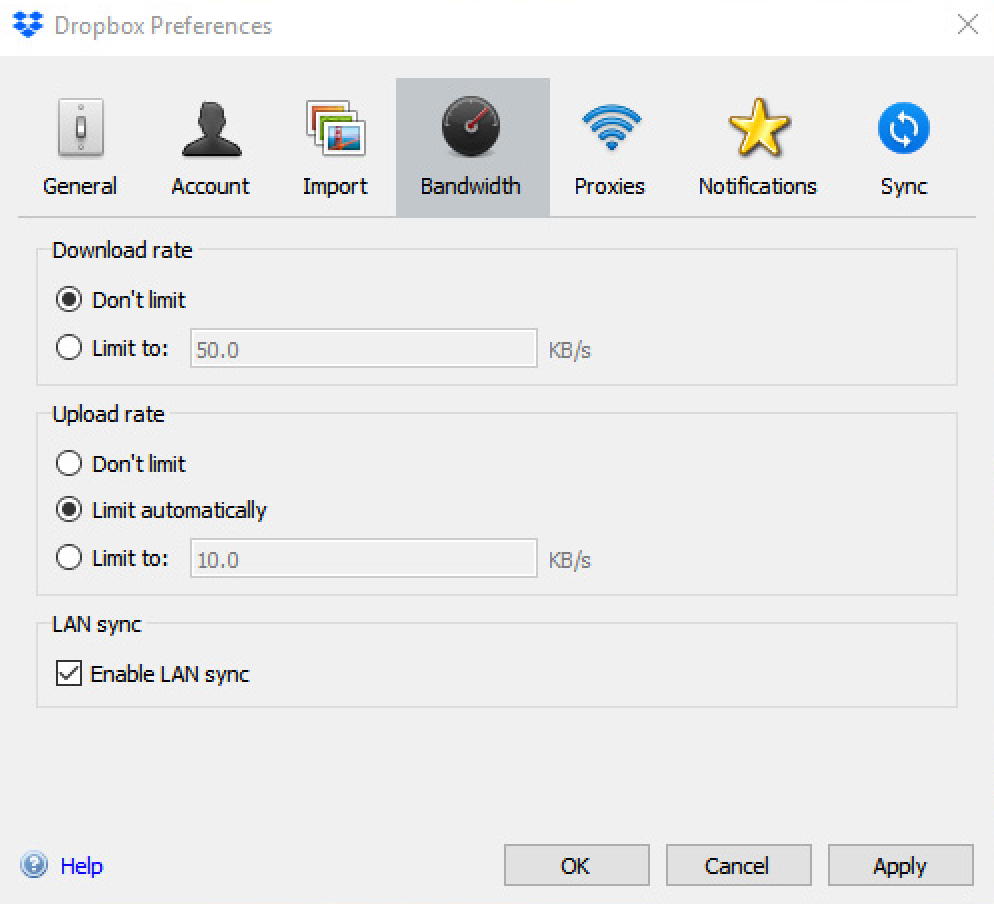
The lack of cake-level file sync and LAN sync makes Google Drive slower (though y'all might not even discover for small files), but it also ways that Google Bulldoze uses more data. If yous take a data cap on your internet, equally many dwelling internet providers practise, and you're transferring large files, Google has a higher adventure of using up your monthly information.
Security
When it comes to security, Google and Dropbox are neck and neck
The only surefire way to proceed your files condom from attackers is to avoid storing them in the deject to begin with. But the files you exercise upload to the deject nonetheless need protection. In this area, both Google and Dropbox made sure all bases were covered.
Google provides two-factor authentication back up, allowing y'all to secure your account by requiring your choice of SMS, an authenticator app, one-tap sign-in on your phone, a phone phone call with a lawmaking, or even a concrete fundamental like the ane Google requires all of its employees to employ. Dropbox supports all of this (with the exception of one-tap sign-in), and is also taking atomic number 82 on passwordless logins through standards such every bit the webauthn.
Google is a bit better at securing your data while it's on their servers, though. Both Google and Dropbox encrypt your data while it's traveling from your computer to their servers. In one case it'southward in the cloud, both generate a cardinal that's used to decrypt it when yous need to access it. Google takes an extra footstep by encrypting that key using a second, rotating master fundamental. This essentially means anyone who could steal data from Google'southward servers would need two keys to read your data, non only the i they'd need if they wanted data from Dropbox'due south servers. Google also encrypts information when it'south in transit between its ain servers. This was an actress footstep the company started taking to protect data from NSA snooping.
In 2016, it was discovered that Dropbox failed to disclose the extent of an earlier breach in 2012, in which Dropbox lost login data on over 68 one thousand thousand accounts. Dropbox implemented many new security measures since the breach (including but not express to the ones mentioned above), so information technology's certainly safer today than it was years ago. Still, if yous're storing very sensitive information, you lot're probably slightly better off with Google.
File browsing and search
Browsing is easy on both, but Google'southward search is leagues smarter
Dropbox and Google Drive both have a desktop app that creates a folder on your estimator to sync between your devices. You tin can scan this folder using Windows Explorer or Finder on a Mac—simply like you would any other folder—or you can browse on the spider web, sorting by file type, who owns the files, or when the files were terminal modified.
Google's app is chosen Fill-in and Sync, and you have to download it separately, and so it's not required in gild to employ Google Drive.
In the web version, Google Drive displays a Quick Access bar along the summit of the page with suggestions of files y'all might demand, east.g., recent files or files that are relevant to your meetings in Google Calendar. You tin also star items as of import, but those end up tucked away in a carve up tab. Dropbox, on the other hand, shows you the files you've uploaded most recently, as well as a row of items yous've starred. In this way, Dropbox gives yous more control over which files you see outset, while Google Drive relies more than on algorithms to approximate your needs. Depending on what y'all prefer, i might exist better, just they both go the chore done.
Where Google excels is in searching your files. In Dropbox, you can search for a specific term or limit your search to subfolders—only that's about information technology. If you pay for Dropbox Professional person or Business, y'all can also search for text in images. Google Drive, on the other mitt, supports search parameters similar to the ones y'all see in Gmail: Y'all tin can search by the type of file, who owns the files, who they're shared with, or when they were final modified.
When information technology comes to searching photos, Google's lead gets even more dramatic. If you lot employ Google Photos to back up pictures with your Google storage, and so the company's powerful AI tin can find faces of people and animals and automatically sort them into albums.
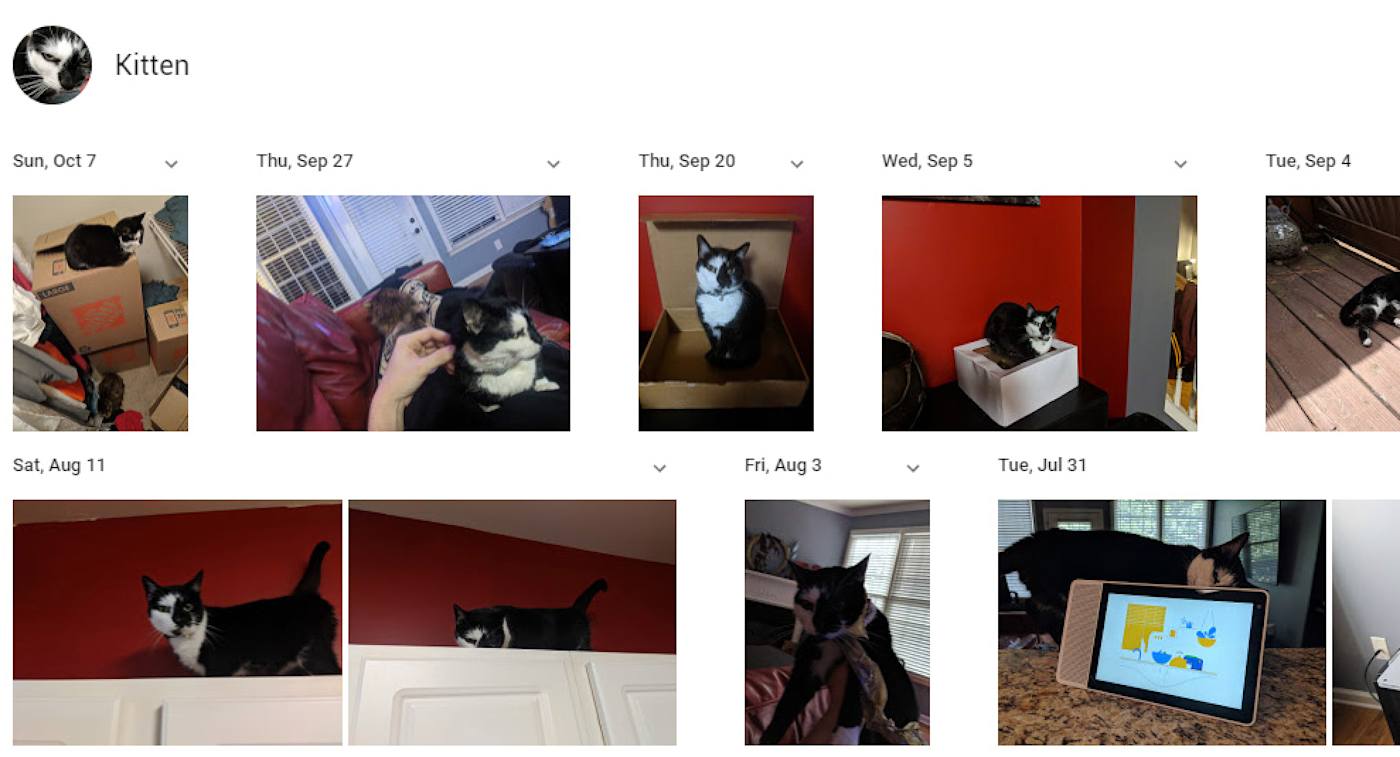
If you accept pictures of receipts or business cards, Google Lens will read and re-create text, phone numbers, or email addresses right from your photos and allow yous to search on that data. Amend notwithstanding, if you lot search for things similar "receipt" or "business card," Google Photos tin can place pictures of those items. Some of these features (like Lens) are only available on mobile, but they're massively convenient.
The Dropbox and Google Drive apps sync your files whenever you have cyberspace access, but all the files are stored locally, then y'all can keep using and editing them when you're on a plane or if your cyberspace goes out. Note: You will need to use Chrome to edit Google Docs offline.
Photo and video backup
Google Photos is a powerful add-on that Dropbox can't friction match
Dropbox and Google tin both automatically support all your photos and videos to the cloud. Dropbox will complete the dorsum upward from your computer, and if you pay for the Dropbox Plus plan or college, y'all tin upload them directly from your phone. Photos and videos take up huge chunks of space, so if you're planning to utilise Dropbox for either one, you lot'll probably want to pay for a higher tier program anyway.
Google Photos, on the other hand, backs upward photos and videos direct from your phone for free. Better yet, any photos smaller than 16MP or videos at 1080p or smaller won't count against your storage limit, and you can automatically scale downwardly your media if y'all don't want to use upwardly your space. So even though videos and email attachments share the same storage limit, Google's flexible and more than generous plans are still more affordable than Dropbox.
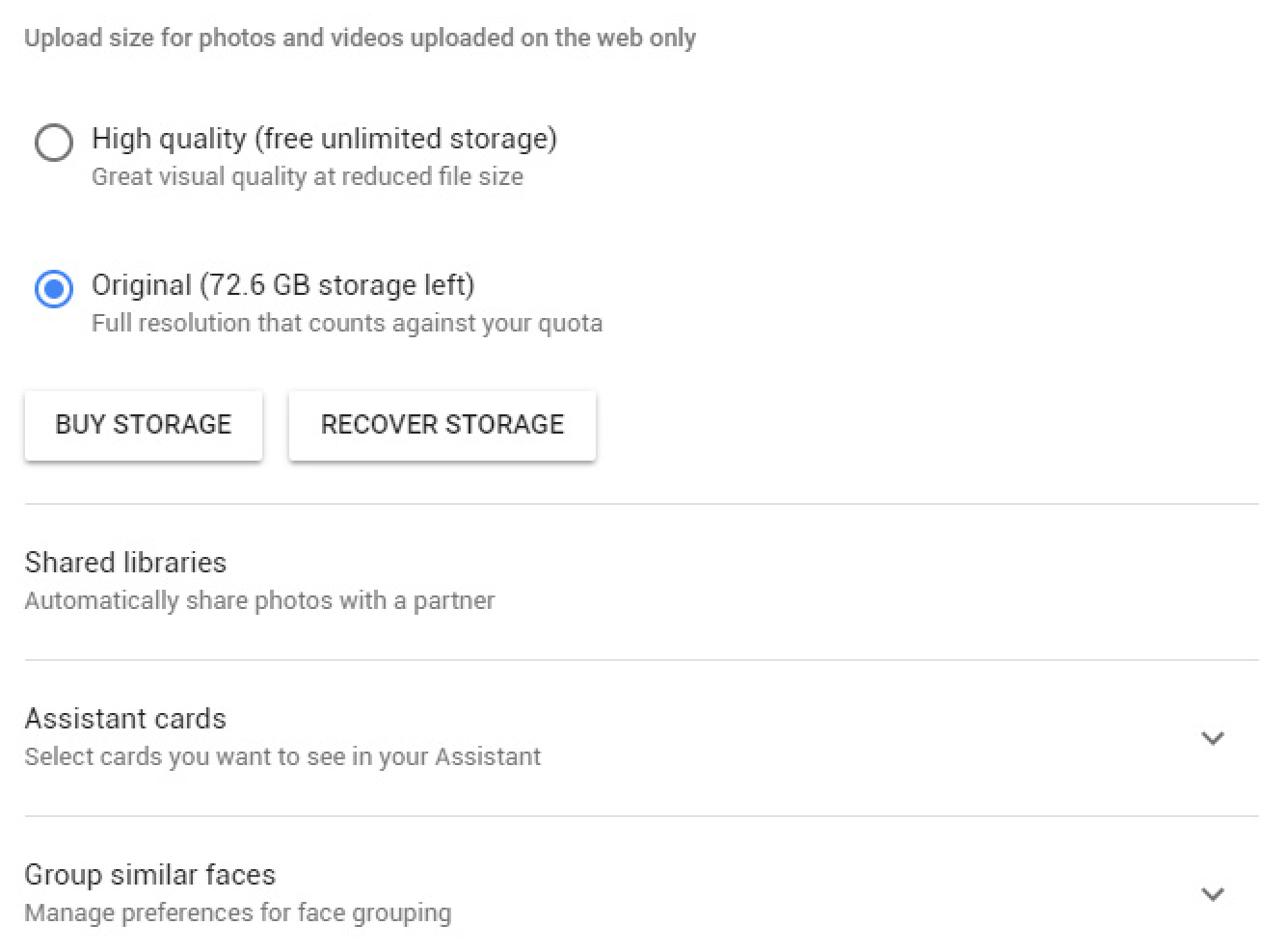
Google likewise beats Dropbox for editing and sharing media. Dropbox has a Camera Uploads folder: You tin can add together comments to pictures or videos, and that's about information technology. To share a group of photos, you create a folder and share it, just there's no longer a way to create and share a photo album. Meanwhile, in addition to regular photo albums, Google Photos lets you create Alive Albums that automatically fill themselves with pictures of people you tag, using Google'south uncanny facial recognition software. For example, you could create a Live Anthology of your spouse and children; so, every photo you lot take of them will conveniently show upwards in the same album.
Google Photos as well includes a basic photo editor that lets you lot tweak calorie-free and color, use Instagram-style filters, or ingather and rotate images. The latter is most useful for businesses, assuasive you lot to rotate photos of receipts or business organization cards to a readable orientation. The Dropbox mobile app tin can do this, only it'south currently non possible on the web. Simply for photographers or media professionals who already use apps similar Lightroom to manage their media, Dropbox works great for storage.
File sharing
Dropbox edges out Google Drive with some advanced features
Dropbox and Google both offering robust options to manage who on your team tin access your files. Both apps let you share private files or entire folders by sending an electronic mail or by sharing a link. If yous choose the erstwhile, yous tin can specify who should take admission and revoke or change those permissions later on on. If you lot share a link, you tin can allow anyone with the link view or edit files, just if you ever want to revoke access, you'll need to disable link sharing entirely.
For the most part, Dropbox and Google Bulldoze are identical on this front, simply Dropbox has a couple advantages. On Dropbox, when you create a shareable link, you can also add a countersign, so only people who know the password can access the files. Y'all can also prepare an expiration appointment, after which the link to your files will stop working. The expiration date can only be set to a sure 24-hour interval—and so, for instance, you tin can't create a link that expires after an hour—but it'south more than Google offers.
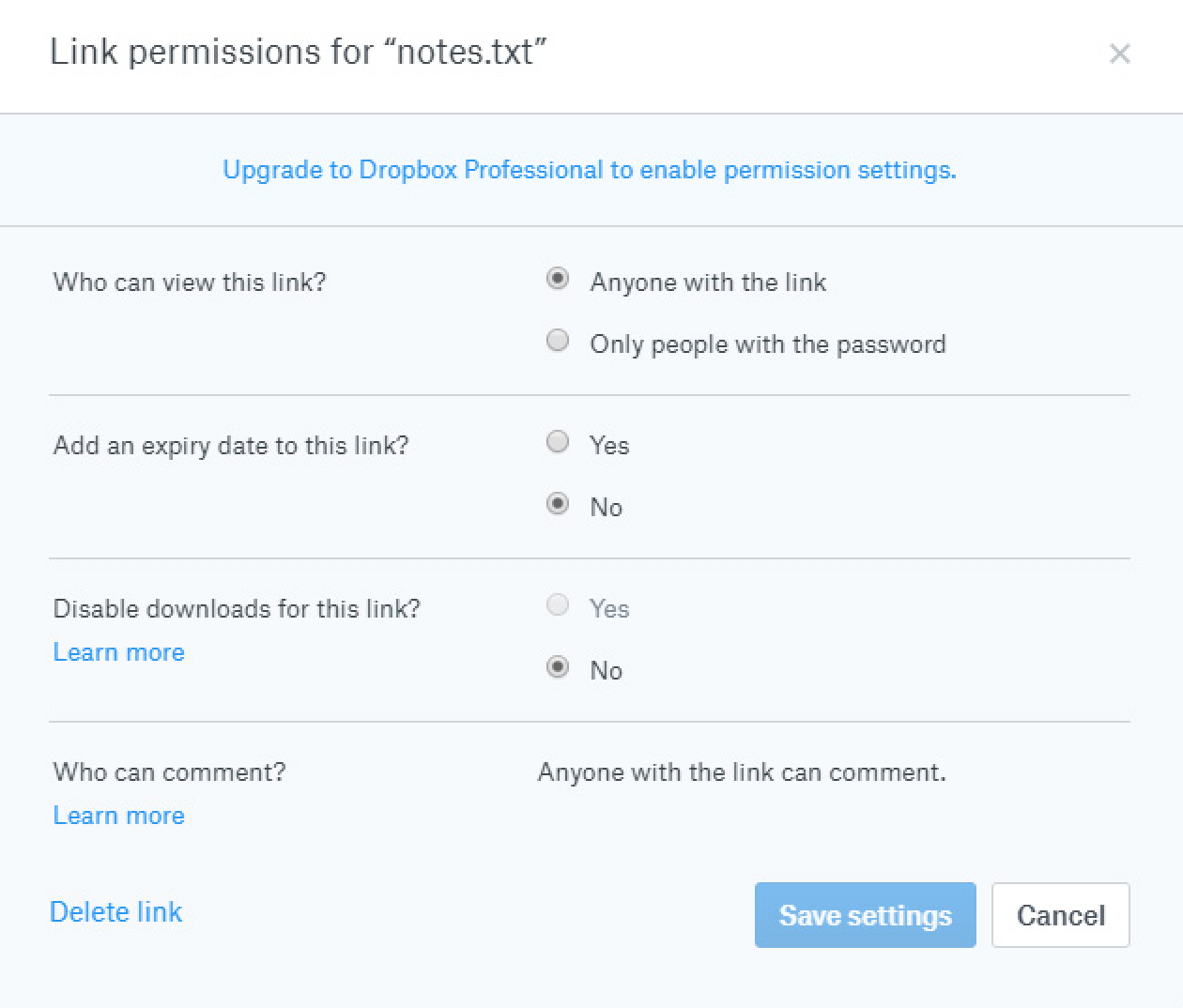
If you use Grand Suite for Business or Education, Google does provide a fashion to set expiration dates on file access. You tin can fifty-fifty give specific users limited fourth dimension access when you invite them by email.
You tin can also share files straight from Explorer or Finder with both apps, but it's slightly easier with Dropbox. If y'all right-click a file or binder on your computer, both services add a shortcut in the context menu to the Share dialog, where you can invite someone to access a file with an email. But Dropbox also adds an option that reads "Copy Dropbox link." This will immediately create a shareable link to the file or folder and copy it to your clipboard. It just saves you a couple of clicks, but if you're sharing files a lot, those clicks can add up.
What near when someone leaves your squad? Dropbox handles this much meliorate than Google. The owner of a file or folder in both apps can promote anyone to owner condition, allowing them to have over control. The new owner can so remove the previous possessor entirely. However, Google can't promote someone outside your system to possessor status. So, for example, if you create a file on your personal Gmail account, you tin't make someone who uses a company Gmail account the owner, or vice versa.
As well, unlike Dropbox, Google Bulldoze doesn't take a method to transfer ownership of all files in an account to someone else. You tin can make someone else in your domain the new owner of several folders at in one case, merely any files inside those folders volition retain their original ownership. You accept to go into each folder level and select everything, which can be quite ho-hum. Additionally, Dropbox gives you lot the selection to allow users to go on a copy of the files you're revoking access to, while Google Drive doesn't. Overall, Dropbox and Google are both expert at sharing files, but Dropbox handles the transition more smoothly when someone leaves your team.
File recovery and modify history
Google Drive stores more than deleted files and has more than detailed change trackers
When multiple people are editing, copying, and transferring files, you need a way to proceed track of who'south changing what. Dropbox and Google Bulldoze both give you tools to restore previous versions of files, just Google'southward broader suite of services gives you more robust options.
With Dropbox, if a file is ever deleted, yous can go into the Deleted Files section of the app or site and restore information technology with the click of a button. You can even filter deleted files by which folder they were in, when they were deleted, or who deleted them. The downside: Dropbox but saves deleted files for up to 30 days for Bones or Plus users (that limit goes up to 120 days if you subscribe to Dropbox Business organization, and 180 days for Dropbox Professional person). Meanwhile, Google puts any "deleted" files in a Trash folder. Even if you've permanently deleted a file from your computer, Google will shop a version in the Trash online. It will stay there forever until y'all empty Drive's Trash, after which point a Thou Suite administrator can still restore information technology for up to 25 days. Information technology'due south a handy serial of fail-safes to forbid unwanted data deletion.
If you need to restore an older version of a file, both Dropbox and Google will permit you get dorsum through up to 30 days worth of older versions of a file. That means if you edit a document, create a new version of a video, or overwrite a PDF, Google and Dropbox volition salve the previous version for a month. Once again, though, Dropbox volition raise that cutoff to 120 days or 180 days for Business and Professional subscribers, respectively. With Google, no thing how much storage you buy with Google 1, you'll still be stuck with 30 days of version history.
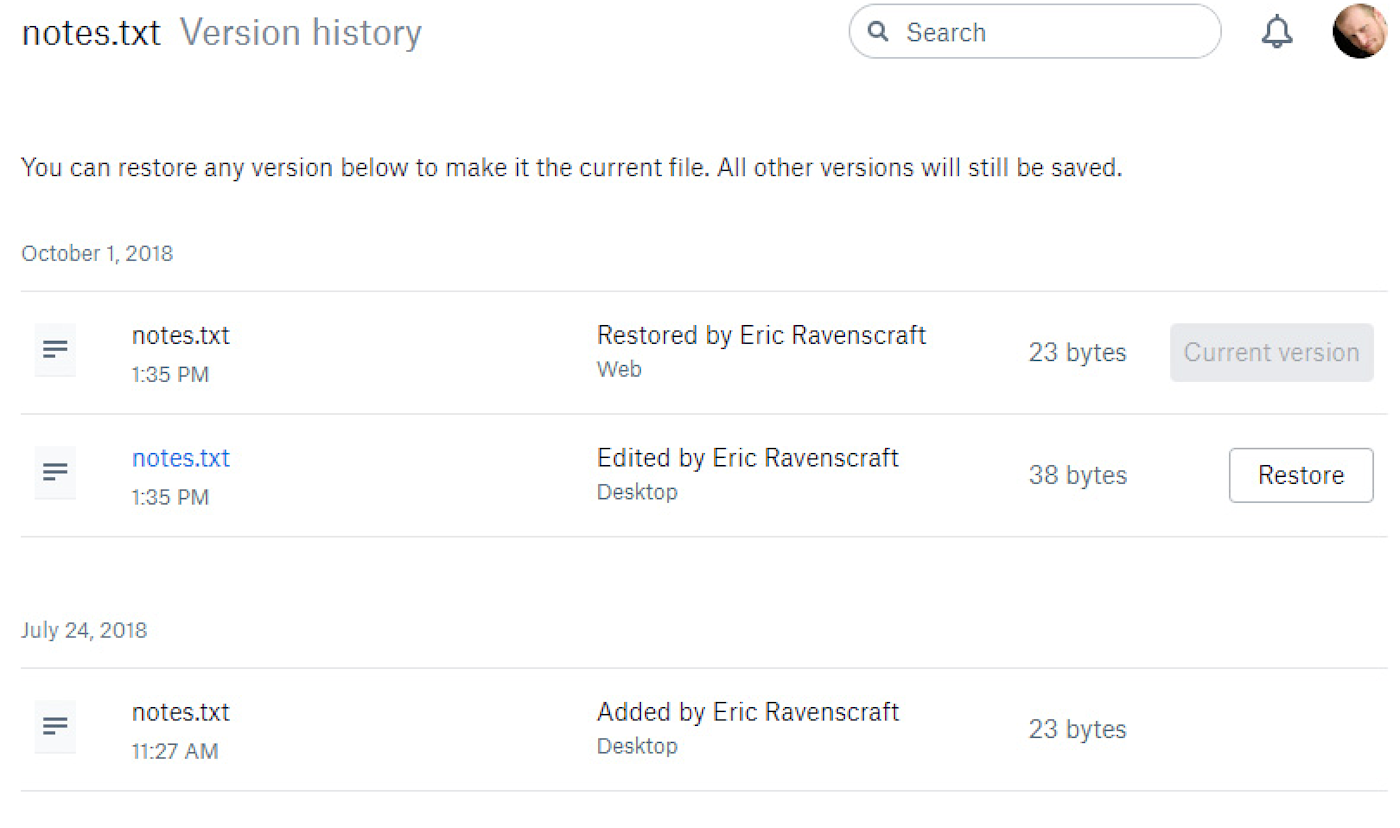
Just Google has one advantage in this surface area. Version history in Google Docs, Sheets, and Slides is top notch. If your team uses Google Docs, you can non only restore previous versions of files, but as well see who made which changes, restore specific versions from the heart of an editing session (since Google automatically saves documents regularly), and even name older revisions to save them for later, separate from the main version you're editing.
This is technically a feature of Google'south function software, not Google Drive itself, but information technology illustrates an important point. Google doesn't simply offering a cloud storage binder. Bulldoze is tightly integrated with a broader collection of apps that piece of work amend in tandem. Dropbox offers shortcuts to create documents in Microsoft Discussion Online, but after that, you're on your ain. Version history is a paid feature of Microsoft Office, and while Dropbox tin can restore older versions of a Give-and-take document, it tin't rail changes the aforementioned way Give-and-take can.
Which cloud storage app should I utilise?
If y'all just desire to sync files and folders betwixt multiple devices, Dropbox is difficult to beat. It's fast, it's reliable, and it works invisibly in the background. Dropbox doesn't come with a lot of actress features, but by focusing on its core product, the company still manages to have i of the best products around.
If yous're looking for a full solution for your business organisation and you lot're not married to other office software or photo management tools, Google Drive offers a compelling example. Its tight integration with Google Photos and G Suite offers a lot of perks that Dropbox only tin can't friction match. And information technology doesn't injure that it'due south a lot cheaper to increase your storage allowance.
Finally, here's an at-a-glance feature comparison.
| Dropbox | Google Drive | |
|---|---|---|
| Pricing | Starts at $11.99/mo ($ix.99/mo when paid annually) for 2TB | Starts at $two/mo for 100GB, $ten/mo for 2TB |
| Speed | Cake-level sync, LAN sync | No cake-level/LAN, fast servers |
| Security | Encrypts data in transit and at balance, 2FA via SMS, app, phone call, physical central, and passwordless login | Encrypts data in transit, at rest, and encrypts keys, 2FA via SMS, app, telephone call, or concrete key |
| File Browsing and Search | Bones file search, tin manually star items for piece of cake admission | "Smart" Quick Access bar automatically pins common files to the top. Supports avant-garde search parameters, and machine learning in Photos search. |
| Photograph and Video Backup | Back up photos and videos from desktop, upload from telephone with Plus or higher subscription. Express past storage available. | Unlimited 16MP or 1080p video uploads, higher-quality limited by storage bachelor. Tin upload from whatsoever device. Google Photos offers advanced sharing and editing capabilities. |
| File Sharing | Basic permission management. Shareable links support countersign protection and expiration dates. One-click shareable links from desktop. | Basic permission and ownership management when sharing files. Difficult to offboard team members. |
| File Recovery and Change History | Can recover files deleted or inverse inside past xxx days. Limit raised to 120 or 180 days with Business organization or Professional person. | Trash folder stores deleted files forever until emptied. Recover older versions of files within 30 days. |
Automate Dropbox and Google Bulldoze
Once y'all've selected a cloud storage app, you can kickoff automating your file backups and notifications.
-
Save new email attachments to your deject storage:
-
Get notified whenever certain files are added to your cloud storage:
-
Or, if you use both apps, y'all can automatically copy files between the two:
Don't see the workflow you're looking for? Browse other Dropbox and Google Drive Zaps, or create your own using the Zap editor.
Updated in Dec 2019 by Marshall Gunnell to reflect Dropbox and Google Drive's latest pricing and Dropbox'southward latest security features
Get productivity tips delivered direct to your inbox
Nosotros'll email you 1-3 times per week—and never share your data.
Source: https://zapier.com/blog/dropbox-vs-google-drive/
0 Response to "Can Anyone Upload a File That Has Sharing Authority to Dropbox?"
Post a Comment